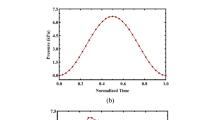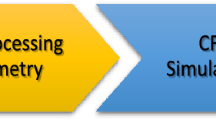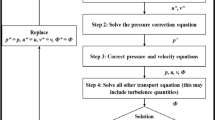Abstract
Moving particle semi-implicit (MPS) method is a mesh-free method to perform computational fluid dynamics (CFD). The purpose of this study was to calculate the simulated fractional flow reserve (sFFR) using a coronary stenosis model, and to validate the MPS-derived sFFR against invasive FFR using clinical coronary CT data. Coronary flow simulation included 21 stenosis models with stenosis ranging 30–70%. Patient coronary analysis was performed in 76 consecutive patients (100 vessels) who underwent coronary CT angiography and subsequent invasive FFR between November 2016 and March 2020. Accuracy of sFFR and CT angiography for diagnosis of invasive FFR ≤ 0.80 was compared. Quantitative morphological stenosis data of CT angiography were also obtained. Area stenosis showed a good correlation to sFFR (R2 = 0.996, p < 0.001) in coronary stenosis models. In the patient study, the mean FFR value was 0.82 ± 0.10, and 37 out of 100 vessels showed FFR ≤ 0.80. FFR and sFFR values showed a good correlation (R2 = 0.59, p < 0.001) with a slight underestimation of sFFR as compared with FFR (mean difference − 0.015 ± 0.096, p = 0.12). The sensitivity, specificity, positive predictive value, and negative predictive value of sFFR to predict FFR ≤ 0.80 was 86%, 89%, 82%, 92%, respectively. The accuracy to predict FFR ≤ 0.80 using sFFR was greater than using diameter stenosis and minimum lumen area (88% vs. 74%, p = 0.008). CFD using the MPS method showed feasible results validated against invasive FFR. The accuracy to predict significant stenosis was higher than morphological stenosis.





Similar content being viewed by others
Data availability
Data available on request due to privacy/ethical restrictions.
Code availability
Coding for the MPS method is available at GutHub (https://github.com/OpenMps/openmps).
Abbreviations
- AUC:
-
Area under the curve
- bpm:
-
Beats per minute
- CI:
-
Confidence interval
- CTA:
-
Computed tomography angiography
- CFD:
-
Computational fluid dynamics
- DS:
-
Diameter stenosis
- LL:
-
Lesion length
- MLA:
-
Minimum lumen area
- MPS:
-
Moving particle semi-implicit
- OR:
-
Odds ratio
- ROC:
-
Receiver-operating characteristics
- sFFR:
-
Simulated fractional flow reserve
References
De Bruyne B, Pijls NHJ, Kalesan B et al (2012) Fractional flow reserve–guided PCI versus medical therapy in stable coronary disease. N Engl J Med 367:991–1001. https://doi.org/10.1056/NEJMoa1205361
Kitabata H, Leipsic J, Patel MR et al (2018) Incidence and predictors of lesion-specific ischemia by FFR CT: learnings from the international ADVANCE registry. J Cardiovasc Comput Tomogr 12:95–100. https://doi.org/10.1016/j.jcct.2018.01.008
Ko BS, Cameron JD, Munnur RK et al (2017) Noninvasive CT-derived FFR based on structural and fluid analysis. JACC Cardiovasc Imaging 10:663–673. https://doi.org/10.1016/j.jcmg.2016.07.005
Röther J, Moshage M, Dey D et al (2018) Comparison of invasively measured FFR with FFR derived from coronary CT angiography for detection of lesion-specific ischemia: results from a PC-based prototype algorithm. J Cardiovasc Comput Tomogr 12:101–107. https://doi.org/10.1016/j.jcct.2018.01.012
Yoshikawa Y, Nakamoto M, Nakamura M et al (2020) On-site evaluation of CT-based fractional flow reserve using simple boundary conditions for computational fluid dynamics. Int J Cardiovasc Imaging 36:337–346
Caballero A, Mao W, Liang L et al (2017) Modeling left ventricular blood flow using smoothed particle hydrodynamics. Cardiovasc Eng Technol 8:465–479. https://doi.org/10.1007/s13239-017-0324-z
Koshizuka S, Oka Y (1996) Moving-particle semi-implicit method for fragmentation of incompressible fluid. Nucl Sci Eng 123:421–434. https://doi.org/10.13182/NSE96-A24205
Kanetsuki Y, Nakata S (2015) Moving particle semi-implicit method for fluid simulation with implicitly defined deforming obstacles. J Adv Simul Sci Eng 2:63–75. https://doi.org/10.15748/jasse.2.63
Perez CA, Garcia MJ (2017) Flow behaviour over a 2D body using the moving particle semi-implicit method with free surface stabilisation. Int J Interact Des Manuf 11:633–640. https://doi.org/10.1007/s12008-016-0338-z
Kamakoti R, Dabiri Y, Wang DD et al (2019) Numerical simulations of MitraClip placement: clinical implications. Sci Rep 9:1–7. https://doi.org/10.1038/s41598-019-52342-y
Mao W, Li K, Sun W (2016) Fluid–structure interaction study of transcatheter aortic valve dynamics using smoothed particle hydrodynamics. Cardiovasc Eng Technol 7:374–388. https://doi.org/10.1007/s13239-016-0285-7
Tomizawa N, Hayakawa Y, Inoh S et al (2015) Clinical utility of landiolol for use in coronary CT angiography. Res Rep Clin Cardiol. https://doi.org/10.2147/RRCC.S77559
Tomizawa N, Yamamoto K, Inoh S et al (2018) Simplified Bernoulli formula to predict flow limiting stenosis at coronary computed tomography angiography. Clin Imaging 51:104–110. https://doi.org/10.1016/j.clinimag.2018.01.018
Huang J, Lyczkowski RW, Gidaspow D (2009) Pulsatile flow in a coronary artery using multiphase kinetic theory. J Biomech 42:743–754. https://doi.org/10.1016/j.jbiomech.2009.01.038
Yang DH, Kang S-J, Koo HJ et al (2019) Incremental value of subtended myocardial mass for identifying FFR-verified ischemia using quantitative CT angiography. JACC Cardiovasc Imaging 12:707–717. https://doi.org/10.1016/j.jcmg.2017.10.027
Bom MJ, Driessen RS, Kurata A et al (2021) Diagnostic value of comprehensive on-site and off-site coronary CT angiography for identifying hemodynamically obstructive coronary artery disease. J Cardiovasc Comput Tomogr 15:37–45. https://doi.org/10.1016/j.jcct.2020.05.002
Nørgaard BL, Leipsic J, Gaur S et al (2014) Diagnostic performance of noninvasive fractional flow reserve derived from coronary computed tomography angiography in suspected coronary artery disease: the NXT trial (analysis of coronary blood flow using CT angiography: next steps). J Am Coll Cardiol 63:1145–1155. https://doi.org/10.1016/j.jacc.2013.11.043
De Geer J, Coenen A, Kim Y-H et al (2019) Effect of tube voltage on diagnostic performance of fractional flow reserve derived from coronary CT angiography with machine learning: results from the MACHINE Registry. Am J Roentgenol 213:325–331. https://doi.org/10.2214/AJR.18.20774
Imanparast A, Fatouraee N, Sharif F (2016) The impact of valve simplifications on left ventricular hemodynamics in a three dimensional simulation based on in vivo MRI data. J Biomech 49:1482–1489. https://doi.org/10.1016/j.jbiomech.2016.03.021
Lluch È, De Craene M, Bijnens B et al (2019) Breaking the state of the heart: meshless model for cardiac mechanics. Biomech Model Mechanobiol 18:1549–1561. https://doi.org/10.1007/s10237-019-01175-9
Ahmadzadeh H, Rausch MK, Humphrey JD (2019) Modeling lamellar disruption within the aortic wall using a particle-based approach. Sci Rep 9:15320. https://doi.org/10.1038/s41598-019-51558-2
Ahmadzadeh H, Rausch MK, Humphrey JD (2018) Particle-based computational modelling of arterial disease. J R Soc Interface 15:20180616. https://doi.org/10.1098/rsif.2018.0616
Narula J, Chandrashekhar Y, Ahmadi A et al (2021) SCCT 2021 expert consensus document on coronary computed tomographic angiography: a report of the society of cardiovascular computed tomography. J Cardiovasc Comput Tomogr 15:192–217. https://doi.org/10.1016/j.jcct.2020.11.001
Nozaki YO, Fujimoto S, Aoshima C et al (2021) Comparison of diagnostic performance in on-site based CT-derived fractional flow reserve measurements. IJC Hear Vasc 35:100815. https://doi.org/10.1016/j.ijcha.2021.100815
Acknowledgements
Part of this study was supported by JSPS KAKENHI Grant Number 21K07573.
Funding
This study was supported in part by JSPS KAKENHI Grant Number 21K07573.
Author information
Authors and Affiliations
Contributions
Concept of the study (NT), data collection (NT, YN, SF, DT, AK, YK, CA, YK, KT, MH, TD, SO), statistical analysis (NT), data interpretation (NT, SF, SA), manuscript preparation (NT), manuscript editing (SF, TD, SO, TM, SA), scientific guarantor (SA).
Corresponding author
Ethics declarations
Conflict of interest
The authors declare no conflicts of interest regarding this study.
Ethical approval
The institutional ethics committee approved this retrospective study.
Informed consent
Written informed consent was waived.
Additional information
Publisher's Note
Springer Nature remains neutral with regard to jurisdictional claims in published maps and institutional affiliations.
Supplementary Information
Below is the link to the electronic supplementary material.
Rights and permissions
About this article
Cite this article
Tomizawa, N., Nozaki, Y., Fujimoto, S. et al. A phantom and in vivo simulation of coronary flow to calculate fractional flow reserve using a mesh-free model. Int J Cardiovasc Imaging 38, 895–903 (2022). https://doi.org/10.1007/s10554-021-02456-0
Received:
Accepted:
Published:
Issue Date:
DOI: https://doi.org/10.1007/s10554-021-02456-0




